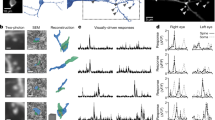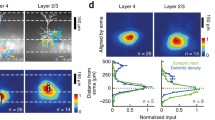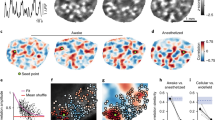Abstract
Much is known about the anatomy of corticocortical connections, yet little is known concerning their physiology. In order to have access to the synaptic and temporal aspects of the activity elicited through corticocortical connections, we developed an in vitro approach on slices of rat visual cortex. We used extracellular recordings of field potentials combined with electrical stimulation to localise regions of areas 17 and 18a that are connected. We found that corticocortical connections between areas 17 and 18a can be preserved in 500 μm thick slices, with a focus of activity separated from the stimulating electrode by 1.5 mm to more than 3 mm. The potentials elicited in one area after stimulation of its neighbour displayed fast events, corresponding to action potentials, and slow events, corresponding to synaptic potentials. Intracellular recordings showed that the earliest synaptic responses consisted of monosynaptic excitatory potentials. Measurement of response latency showed that axons involved in both feedforward and feedback corticocortical connections are slowly conducting (0.3–0.8 m/s). Conduction velocity for antidromically activated cells was not significantly different for the two sets of connections. In an attempt to establish the spatial organisation of functional synaptic inputs, field potential recordings were performed in the different cortical layers and used to establish current source density (CSD) graphs along the depth axis. The CSD maps obtained were found to be somewhat variable from one case to another. It is suggested that this variability results from the use of electrical stimulation, which activates axons that are both afferent and efferent to a given cortical area. The field potentials are therefore likely to contain responses that correspond to the activity mediated by the intrinsic collaterals mixed in variable amount with responses produced by corticocortical synapses. With this restriction in mind, it is suggested that, after stimulation of the supragranular layers, the functional synaptic inputs of feedforward connections are concentrated in layer 4 and the bottom of layer 3, while those of feedback axons involve mainly the upper part of the supragranular layers. The intrinsic collaterals of the neurones participating in corticocortical connections seem also to provide the bulk of their inputs to the upper part of the supragranular layers. The laminar pattern of activity obtained after infragranular layer stimulation was comparable to that obtained after supragranular layer stimulation, except for the addition of a supplementary region of activated synapses in the infragranular layers.
Similar content being viewed by others
Author information
Authors and Affiliations
Additional information
Received: 28 February 1996 / Accepted: 31 January 1997
Rights and permissions
About this article
Cite this article
Nowak, L., James, A. & Bullier, J. Corticocortical connections between visual areas 17 and 18a of the rat studied in vitro: spatial and temporal organisation of functional synaptic responses. Exp Brain Res 117, 219–241 (1997). https://doi.org/10.1007/s002210050218
Issue Date:
DOI: https://doi.org/10.1007/s002210050218




